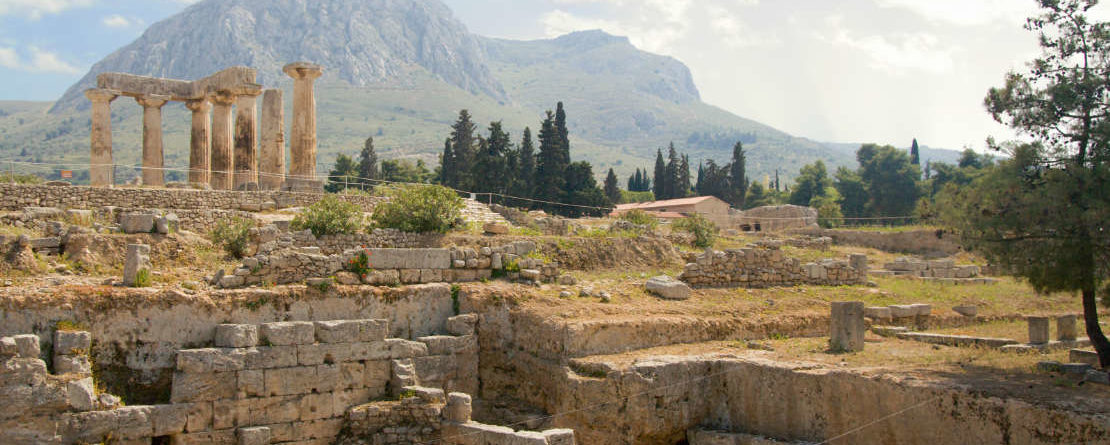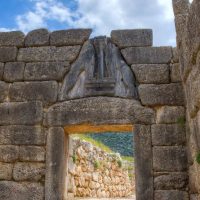
Corinth Canal
The Corinth Canal is a waterway that cuts through the narrow Isthmus of Corinth, connecting the Saronic Gulf of the Aegean Sea to the Corinthian Gulf of the Ionian Sea, thus separating the Peloponnesian peninsula from mainland Greece, making the former an island.
Completed in 1893, it was excavated at sea level and measures 6343m long consisting of a single 8m deep channel, 24.6m wide at water level, and 21m wide at the bottom, with a one-way transit system. The limestone walls rise 80m at their highest point, at a near-vertical angle, ranging from 71° to 77°. The canal is crossed by a railway line, a road (old national highway) and the relatively new motorway. In 1988 two submersible bridges were installed, one at the eastern harbour of Isthmia, and the other at the western harbour of Poseidonia.
Although the canal saves 250 km, it can not accommodate anything wider than 16.5m, and draft deeper than 7.3m, making it too narrow for most modern ocean liners and freighters. Additionally, the high walls channel gusty winds down its length, and the different times of the tides between the two gulfs generate strong tidal currents making navigation difficult, forcing larger vessels to be towed through by tugboat causing further delays due to the one-way transit system. On account of these limitations, nowadays, it is mainly used by approx. 12,000 recreational watercraft per year.

Corinth
The ancient city-state of Corinth was situated one third of the way between Athens and Sparta, near the Isthmus -the narrow stretch of land connecting Peloponnesus to mainland Greece. Established on the northern slopes of the hill of Akrokorinthos, which acted as the acropolis (fortified citadel), the ancient megalopolis flourished mainly because of its location on the isthmus – an active transshipment port for merchandise and trading goods – and played a crucial role in the ancient world, both in prosperity and political dominance, reaching economic peak between the 7th & 6th c. BC. After founding two important colonies, Corcyra and Syracuse, Corinth gradually became one of the wealthiest and most influential city-states, and, along with Athens, and Sparta, remained a major power throughout the Hellenistic period until the rise of the Roman Empire. Despite being vanquished in 146 BC by the Roman conquest, in 44 AD, Julius Caesar re-established the city as the provincial capital of the Eastern Roman Empire.
Dominating the archaeological site, the remains of the Temple of Apollo lie on the highest point of the grounds, offering a wonderful view, extending as far as the Corinthian Gulf, making it a favourite spot for photos. The archaic site was inhabited from at least as early as 6500 BC. The temple is dated to 540 BC and was built, in typical Doric peripteral style with (6×15) monolithic columns, to replace an earlier structure from 700 BC. Around it evolved the commercial, cultural and religious centre of the city including the agora, other smaller temples and sanctuaries, theaters, fountains and various public buildings. Before excavation began revealing the scale of the find, only the columns of the temple were visible.
For Christians, Corinth is known from two books, the I and II Corinthians in the New Testament, written by Apostle Paul, largely in connection to his mission there. Paul first visited the city (51 or 52 AD) , having lived there for eighteen months.
Nemea
Nemea famously known from mythology, where Hercules slayed the Nemean lion, the first of his twelve labours set by his brother, King Eurystheus.
Situated in the northern part of Peloponnesus, 19km southwest of Corinth and 10km north of Mycenae near the foothills of the Arcadian mountains, 333m above sea level in a long narrow valley which has cool summers and harsh winters, often with snow. The area had been inhabited since Early Neolithic times (6000 BC) and was settled throughout the Bronze Age with architectural remains dating from the Mycenaean civilization. Later becoming a religious sanctuary where from 573 BC until 231 BC the Nemean pan-Hellenic athletic games were held every two years.
The archaeological site is dominated by the Temple of Nemean Zeus constructed in 330 BC, during the sanctuary’s peak. Erected on an earlier temple from the 6th c. BC which was destroyed by fire, from which blocks were used to construct the foundations of the new temple built of local limestone covered in fine marble-stucco, it housed within a huge cult statue of Zeus. The entrance, rather than using the common Hellenistic featured steps, was via a large ramp, furthermore, there was no exterior sculptures or decorations either, making it probably the last of the great Doric temples, signifying the end of the Classical period, presaging decadence of Hellenistic culture and architecture. The wooden and terracotta tiled roof collapsed in the 2nd century BC and in the 5th century AD the majority of columns collapsed, by removing blocks from the stylobate.
Today, several columns have been re-erected using the original drums, most of which still lay scattered around the structure. There is also a museum on site exhibiting many of the artifacts found during the excavation.
Mycenae
The Tomb of Clytemnestra was discovered by chance by the local villagers, unfortunately when was already looted. The tomb was conventionally ascribed to Clytemnestra, wife of king Agamemnon, mythical ruler of Mycenae and leader of the Greeks in the Trojan War, and considered to be the latest (1250-1220 BC) of the funerary monuments at Mycenae.
Of the nine tholos tombs at Mycenae, the Tomb of Clytemnestra and the Treasury of Atreus had the most splendidly dressed facades, monumentally decorated and sculpted with a variety of materials, with distinctive construction feature the use of megalithic limestone boulders. The outer walls are typical ashlar block in course masonry, commonly known as Cyclopean style. The passage (“dromos”) was blocked at the south end by a low wall made of limestone and the entrance (“stomion”) was closed by a double door. The facade of the tomb was decorated with two gypsum half-columns, embellished with sculpted ornaments -which have not survived. The area was buried in Hellenistic times and a theatre constructed on top of it, of which stone seats can be seen above the dromos of the tomb.
In the Ancient Greek Tragedy Oresteia, by Aeschylus, Clytemnestra, queen of Mycenae, wife of King Agamemnon, murdered him upon his victorious arrival from the Trojan War in revenge for sacrificing their daughter Iphigenia to goddess Artemis in return for favorable winds which prevented the combined Greek fleet from sailing out of Aulis where they had gathered to set off for Troy. Nonetheless, in Homer’s Odyssey, her role in Agamemnon’s death is unclear and her character is significantly more subdued.

Peloponnese Tour Full Day
9 Hours | 1 to 4 Persons
ITINERARY
- Pickup from your location
- Isthmus of Corinth
- Ancient Corinth
- Ancient Nemea
- Mycenae
- Drop off to your location
Included
- Transfer in new, luxury air-conditioned car (Max: 4 persons)
- Pick up / drop off from your location or cruise ship Terminal (pier)
- Professional local English speaking driver/guide
Not Included
- Food and drinks
- Entrance fees at any point of interest
